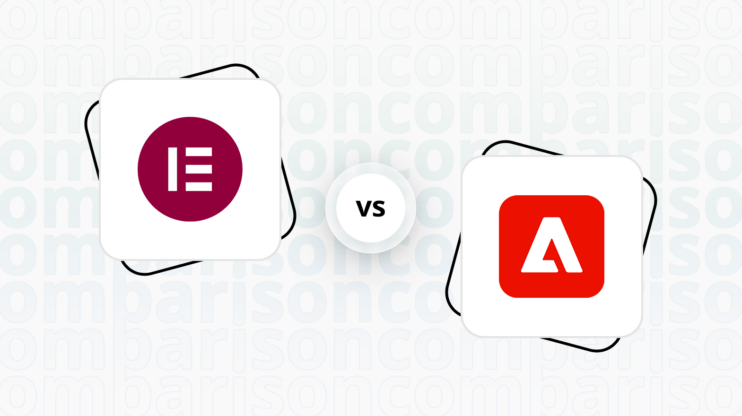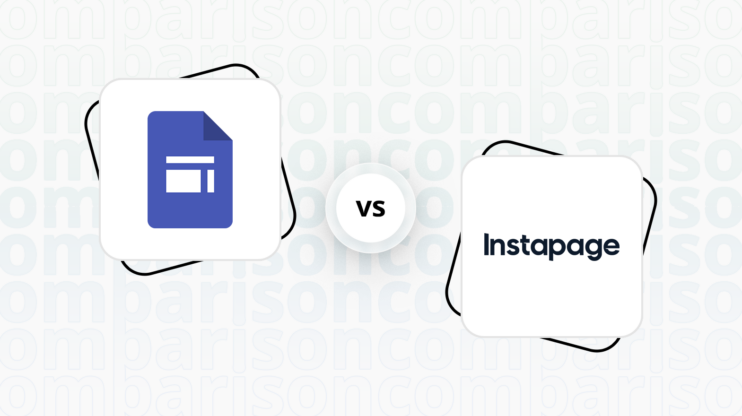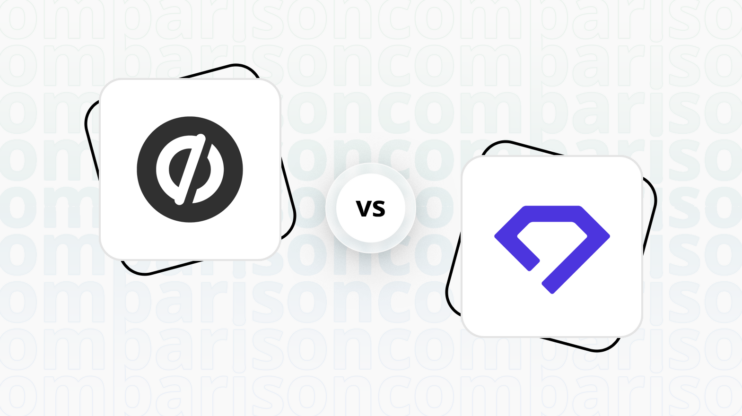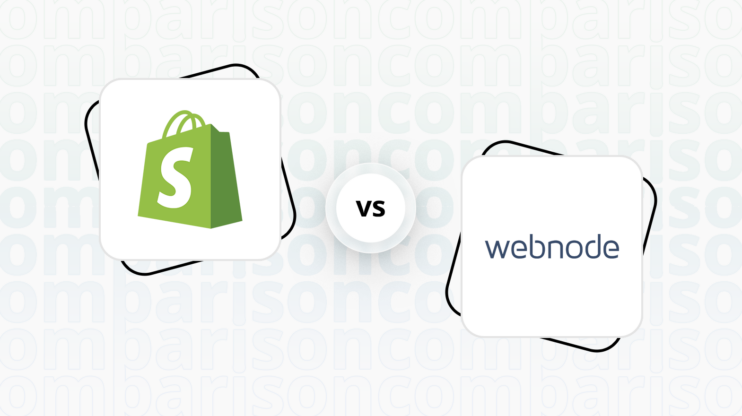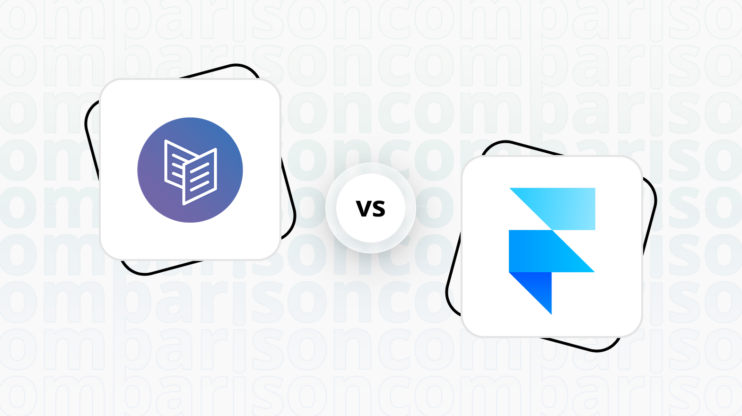Final verdict
Webflow and Portfoliobox both offer unique strengths, catering to different user needs and preferences.
-
Webflow (Overall Grade: 7.9/10)
is a powerful platform designed for professional designers and developers. It excels in providing robust design tools, flexible CMS, and top-tier hosting services. Webflow is ideal for users who need advanced customization and are comfortable with a steeper learning curve. Its comprehensive ecommerce features, superior website speed optimization, and extensive marketing tools make it a strong choice for businesses looking to create highly customized, responsive websites. -
Portfoliobox (Overall Grade: 6.1/10)
is tailored for creative professionals seeking an easy-to-use platform to showcase their work. It offers a user-friendly interface, customizable templates, and essential ecommerce functionalities without requiring technical skills. Portfoliobox is perfect for artists, photographers, and other creatives who need a straightforward solution to build and manage their online portfolios. Its intuitive design and comprehensive toolset make it a versatile option for those prioritizing ease of use and simplicity.

|

|
|
|---|---|---|
|
Design functionalities & templates |
8.6 |
7.5 |
|
Ease of use |
7.5 |
8.1 |
|
Ecommerce |
8.5 |
5.8 |
|
Website Editors |
9.0 |
7.5 |
|
Product testing options |
6.3 |
9.1 |
|
Price |
8.0 |
7.9 |
|
Hosting quality |
8.9 |
6.5 |
|
Website speed optimization |
8.1 |
6.4 |
|
Plugins/extensions and integrations |
5.5 |
7.2 |
|
Marketing features |
7.8 |
7.0 |
|
Customer support |
8.3 |
7.0 |
|
Website security |
7.8 |
8.1 |
|
AI capabilities |
8.3 |
0 |
|
User Management |
8.3 |
2.8 |
Best for ecommerce
 8.5
8.5
 5.8
5.8
Verdict
: Webflow is a more robust and flexible ecommerce solution, while Portfoliobox is better suited for creative professionals looking for a simple, commission-free platform.
-
Webflow
: Webflow stands out with its comprehensive ecommerce features, including extensive customization options, integration with major payment gateways, and advanced marketing tools. It is ideal for businesses looking for a scalable and flexible ecommerce platform. However, when comparing Webflow vs Portfoliobox, Webflow might be more complex for users without technical skills. -
Portfoliobox
: Portfoliobox offers a user-friendly platform tailored for creative professionals. It provides essential ecommerce functionalities like secure checkout and order management without charging transaction commissions. However, it may lack the advanced features and flexibility needed for larger or more complex online stores.
Best for informational & business websites
 8.6
8.6
 7.5
7.5
Verdict
: Webflow is the superior choice for creating informational and business websites, offering advanced design tools and robust hosting services. Portfoliobox, while user-friendly and tailored for creative professionals, falls short in comparison to Webflow’s comprehensive features.
-
Webflow
: Scoring 8.6, Webflow excels in providing a powerful design experience with a wide range of templates and customization options. It is ideal for professional designers and businesses looking for a high degree of control over their website’s appearance and functionality. Webflow’s advanced design tools, flexible CMS, and top-tier hosting services make it a comprehensive solution for creating custom, responsive websites. -
Portfoliobox
: With a score of 7.5, Portfoliobox is designed for creative professionals who need an easy-to-use platform to showcase their work. It offers a variety of customizable templates and drag-and-drop functionality, making it accessible to users without technical skills. While it provides essential features for portfolio websites, it lacks the advanced design capabilities and flexibility that Webflow offers. When comparing Webflow vs Portfoliobox, Portfoliobox is a solid choice for creatives but may not meet the needs of more complex business websites.
Detailed comparison
Design functionalities & templates
Design FunctionalitiesRepresents how well each platform allows for creative design and customization of websites.Score Components:
- Template Variety (30%): Range and quality of design templates.
- Customization (30%): Flexibility and options for design alterations.
- User Interface (20%): Ease and intuitiveness of the design process.
- Responsiveness (10%): Adaptability to different devices and screen sizes.
- Innovation (10%): Unique design features and tools.
 8.6
8.6
 7.5
7.5
🏆
Winner: Webflow.
If you’re looking for a platform with robust design tools and a vast selection of templates, Webflow is the preferred choice.
Webflow delivers a robust design experience with a diverse range of template and customization options. Boasting over 1000 pre-built templates covering various industries and website types, including free and premium options, Webflow ensures a constantly evolving library for users. Templates are categorized for easy browsing, considering industry, website type, style, and features. The design customization features include a visual drag-and-drop editor for real-time adjustments, fine-grained control over every aspect of the design, and the ability to inject custom code for advanced users seeking additional personalization and unique functionalities.
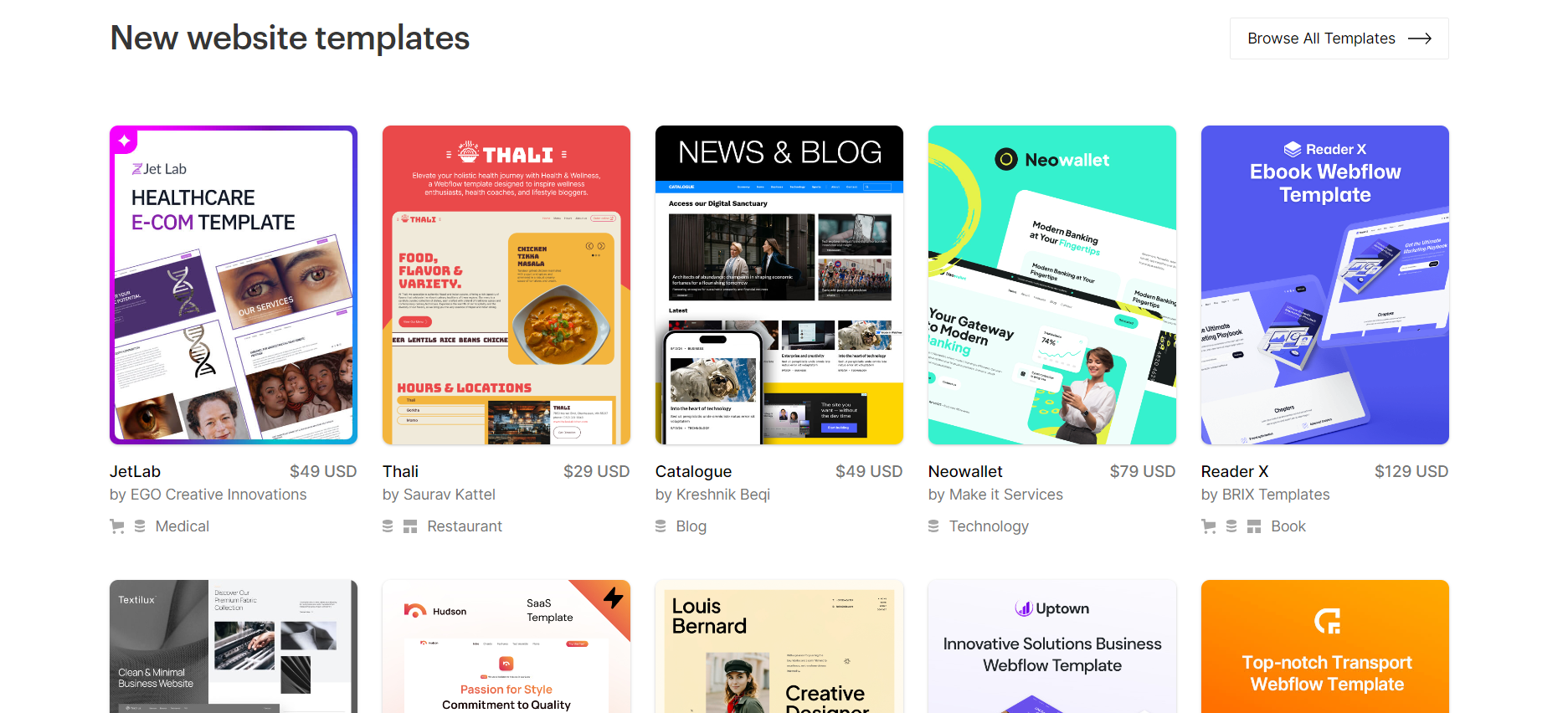
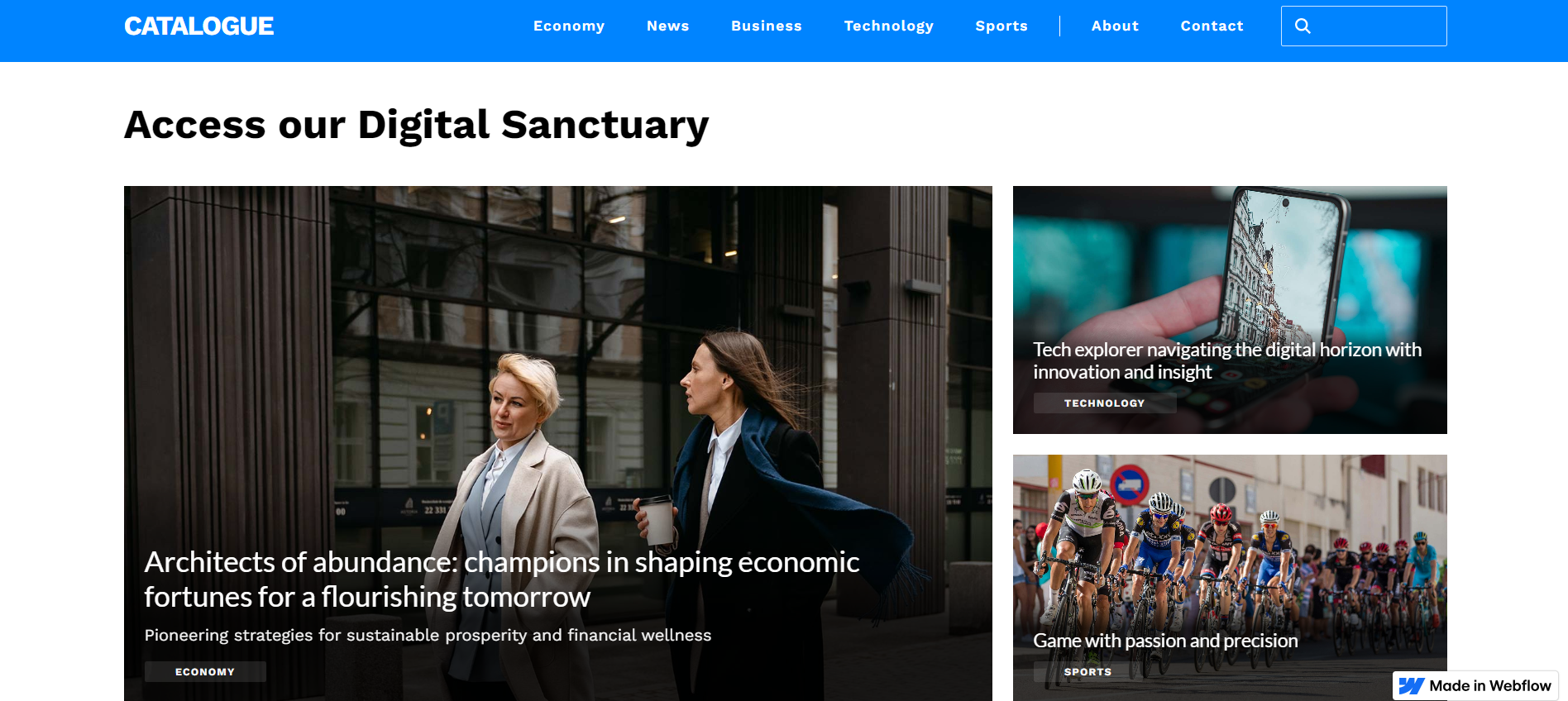
Compared to Webflow, Portfoliobox is a user-friendly platform that allows for the creation of professional portfolio websites, accessible to individuals at any skill level. It offers over 30 customizable templates tailored to a variety of professional needs and preferences, including galleries, blogs, and online stores. The platform also provides features for enhanced functionality such as Adobe Lightroom integration, SSL security, marketing tools, and SEO-friendly options. With its intuitive design and comprehensive toolset, Portfoliobox serves as a versatile solution for creatives looking to establish or expand their online presence.
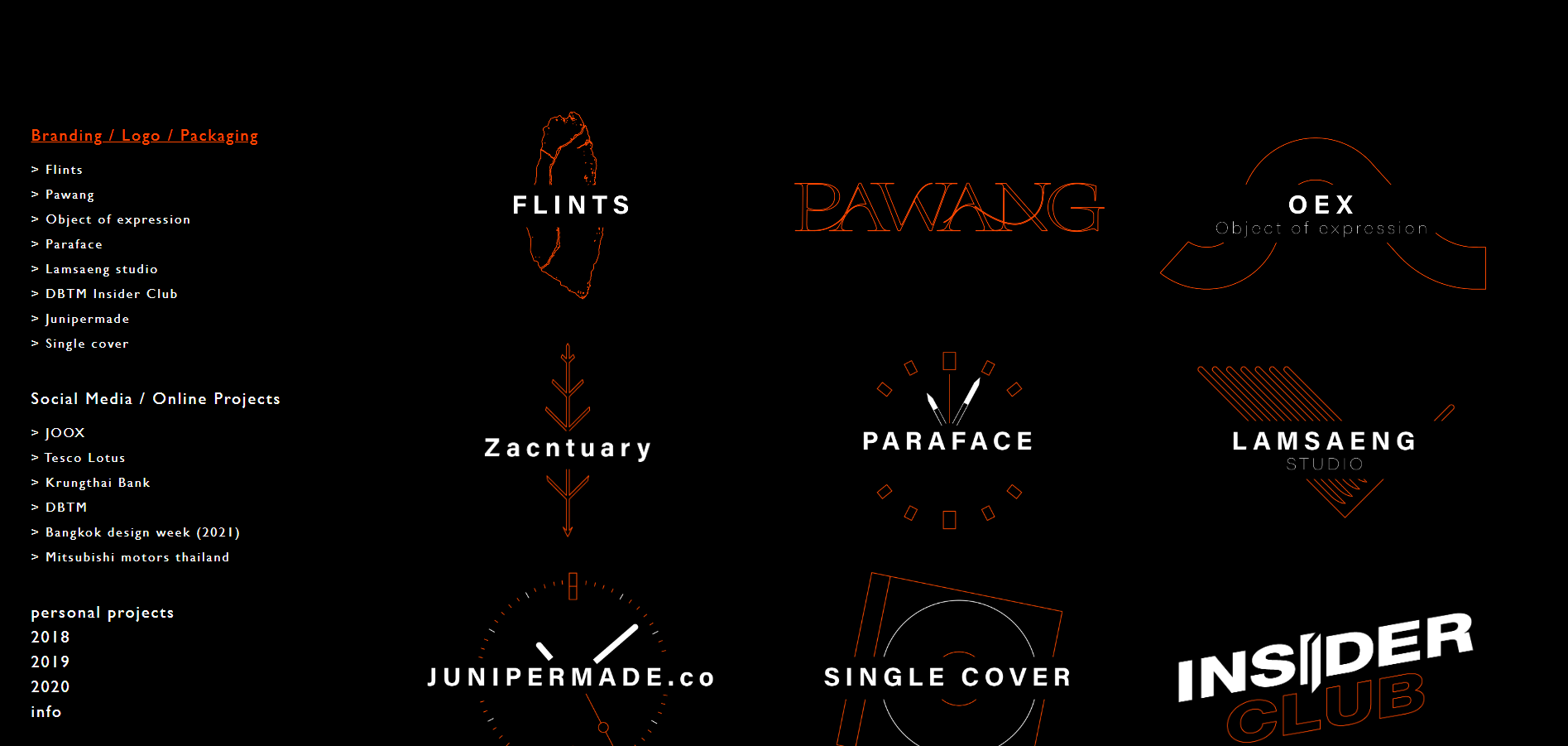
Get a head start on website creation with AI
Create a custom website tailored to your business needs 10X faster with 10Web AI Website Builder!
Ease of use
Ease of useReflects the platform’s overall user-friendliness.Score
Components:
- Learning curve (40%): Quickness and ease of getting started.
- Interface design (30%): Simplicity and intuitiveness of layout.
- User guidance (20%): Quality of tutorials and support.
- Flexibility (10%): Adaptability to various user skills.
 7.5
7.5
 8.1
8.1
🏆 Winner: Portfoliobox
. Scoring 8.1, Portfoliobox is designed with creative professionals in mind, offering an intuitive drag-and-drop interface and customizable templates that make it easy to create stunning portfolios without technical skills. Webflow, with a score of 7.5, provides powerful design tools and flexibility but has a steeper learning curve, making it more challenging for beginners.
Learning Resources
🏆 Winner: Webflow
. Webflow offers a comprehensive set of learning resources, including Webflow University, a YouTube channel, and an active community forum, making it easier for users to learn and master the platform. Portfoliobox also provides helpful resources, but they are more limited in scope.
For ecommerce
EcommerceMeasures the platform’s effectiveness in supporting online business activities.Score Components:
- Ecommerce themes and templates (20%): Variety and design of templates.
- Product management (25%): Ease of managing and organizing products.
- Payment options (25%): Variety and convenience of payment methods.
- Ecommerce features (20%): Features for managing an ecommerce store.
- Integration (10%): Compatibility with external e-commerce tools and services.
 8.5
8.5
 5.8
5.8
Webflow is a robust platform for creating online stores, offering comprehensive ecommerce features such as easy store creation without coding, extensive customization options, product management with variations, inventory tracking, integration with major payment gateways, automated shipping calculations, tax configuration, and marketing tools like abandoned cart recovery and email marketing. Portfoliobox, on the other hand, offers various ecommerce features designed for creatives, including a secure checkout, commission-free selling, and order management. However, it may have limitations for businesses seeking advanced functionality due to its niche-specific nature.

|

|
|
|---|---|---|
|
Ecommerce themes and templates |
7.5 |
3.0 |
|
Product page customization |
8.3 |
6.0 |
|
Payment processing and commissions |
7.8 |
7.0 |
|
POS capabilities |
6.5 |
2.0 |
|
Payment gateways |
8.0 |
5.0 |
|
Product numbers |
7.0 |
5.5 |
|
Additional ecommerce features |
7.9 |
4.5 |
Webflow ecommerce features:
- Checkout and Payment Processing with Stripe, PayPal, etc.
- Marketing and Promotions
- Tax and Shipping calculations
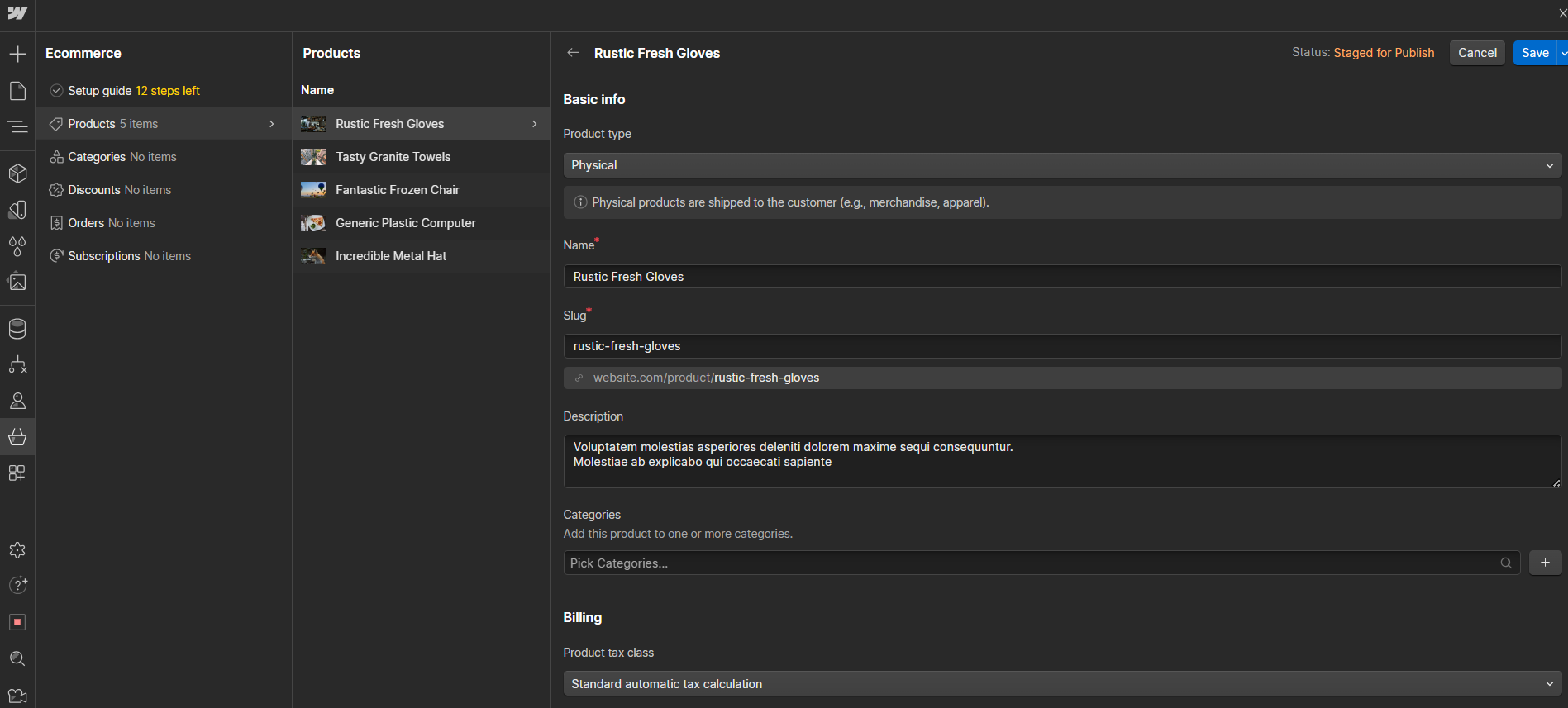
Portfoliobox ecommerce features:
- Product listings
- Payment Gateways integrations
- Shipping rates and tax calculations
- Order management
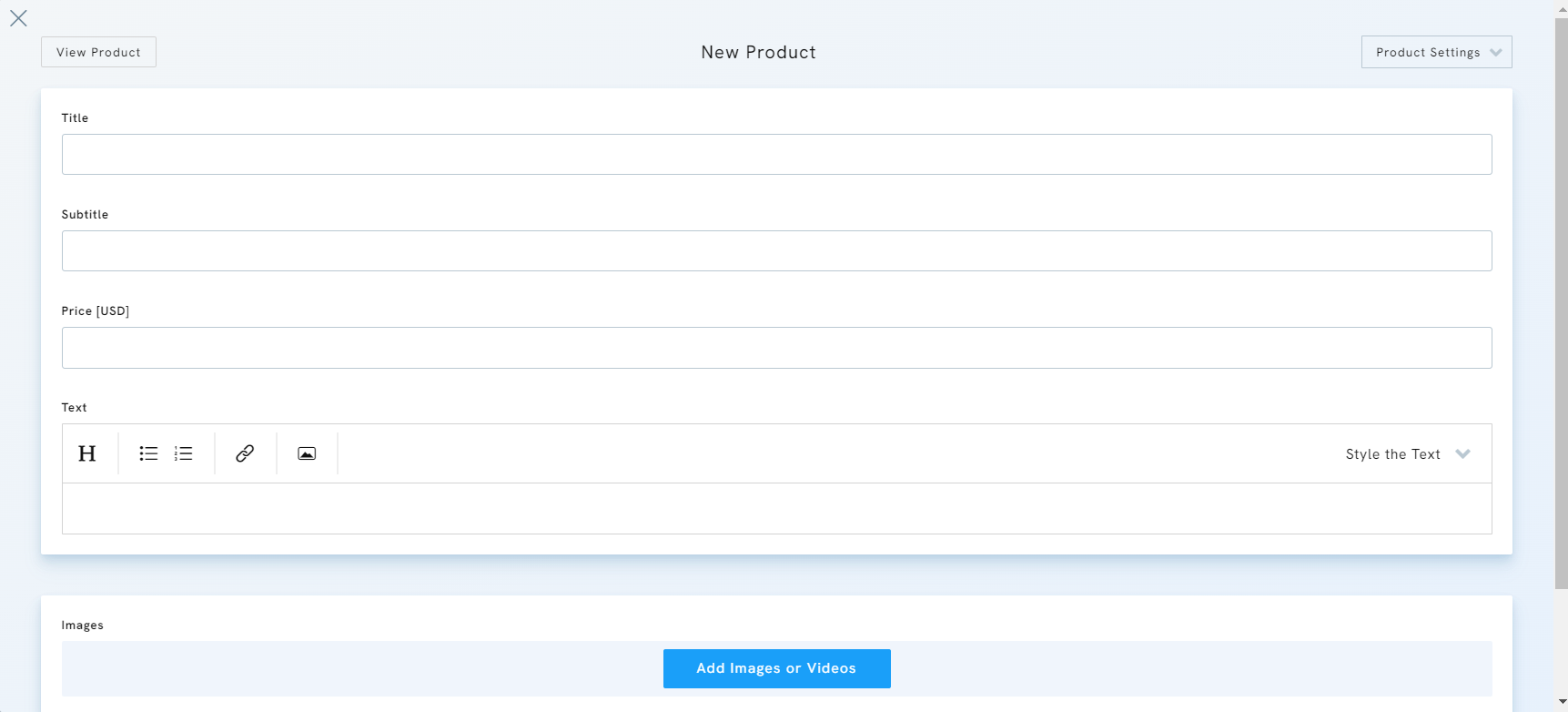
Ecommerce themes & templates
Webflow offers a diverse range of ecommerce themes and templates designed to cater to various types of online stores, from fashion and technology to artisan crafts and children’s products. Each template comes equipped with built-in ecommerce functionality, allowing you to easily add products and manage your store without the need for coding. In contrast, Portfoliobox does not have ecommerce-specific templates, which may limit the design flexibility for online stores.
Product page customization
Webflow offers extensive customization options for ecommerce product pages, allowing users to design and personalize their pages without coding. It provides tutorials for creating product pages from scratch, offers responsive templates for various devices, and allows users to add custom code and dynamic content using Webflow’s CMS for maximum customization flexibility. Portfoliobox offers a streamlined process for customizing product pages on its website builder. Users can create a product by adding details like title, description, and media, set a release date, and manage inventory and tax options. They can also edit product settings, such as the URL and shipping options, and apply discounts.
Payment processing
Webflow provides a flexible and secure platform for payment processing and ecommerce through integrations with leading payment gateways like Stripe and PayPal. This allows users to accept a wide range of payments, including credit card transactions directly from their websites. Given the versatility of Stripe and PayPal, businesses can manage online sales efficiently. Portfoliobox supports selling prints, art, craft, or services online through its ecommerce solution, and notably, they do not charge any commission for transactions made through their platform. While specific payment gateways are not detailed, Portfoliobox mentions accepting credit card payments (Visa, Master, & Maestro) for its subscriptions, implying these may also be supported for transactions within its ecommerce functionality.
Considering the features, availability, cost, and flexibility, Webflow appears to be a more robust and flexible ecommerce solution compared to Portfoliobox. However, for creative professionals looking for a simple, commission-free platform to sell their work, Portfoliobox might still be worth considering.
Website Editors
Website EditorsEvaluates the platforms’ website building and editing capabilities.Score Components:
- Customization tools (40%): Range and power of editing features.
- Editor usability (30%): User experience within the editor.
- Design flexibility (20%): Freedom in layout and design changes.
- Update and maintenance ease (10%): Simplicity of updating and maintaining the site.
 9.0
9.0
 7.5
7.5
🏆
Winner: Webflow
. Webflow, with a score of 9.0, is a cloud-based platform that combines web design, CMS, and hosting, enabling users to visually design responsive websites without writing code. It offers a drag-and-drop interface, integrated SEO tools, ecommerce functionalities, and the ability to add animations and interactions, making web development accessible for designers and powerful for developers. Webflow streamlines the process of web creation, from design to launch, offering both high customization and ease of use.
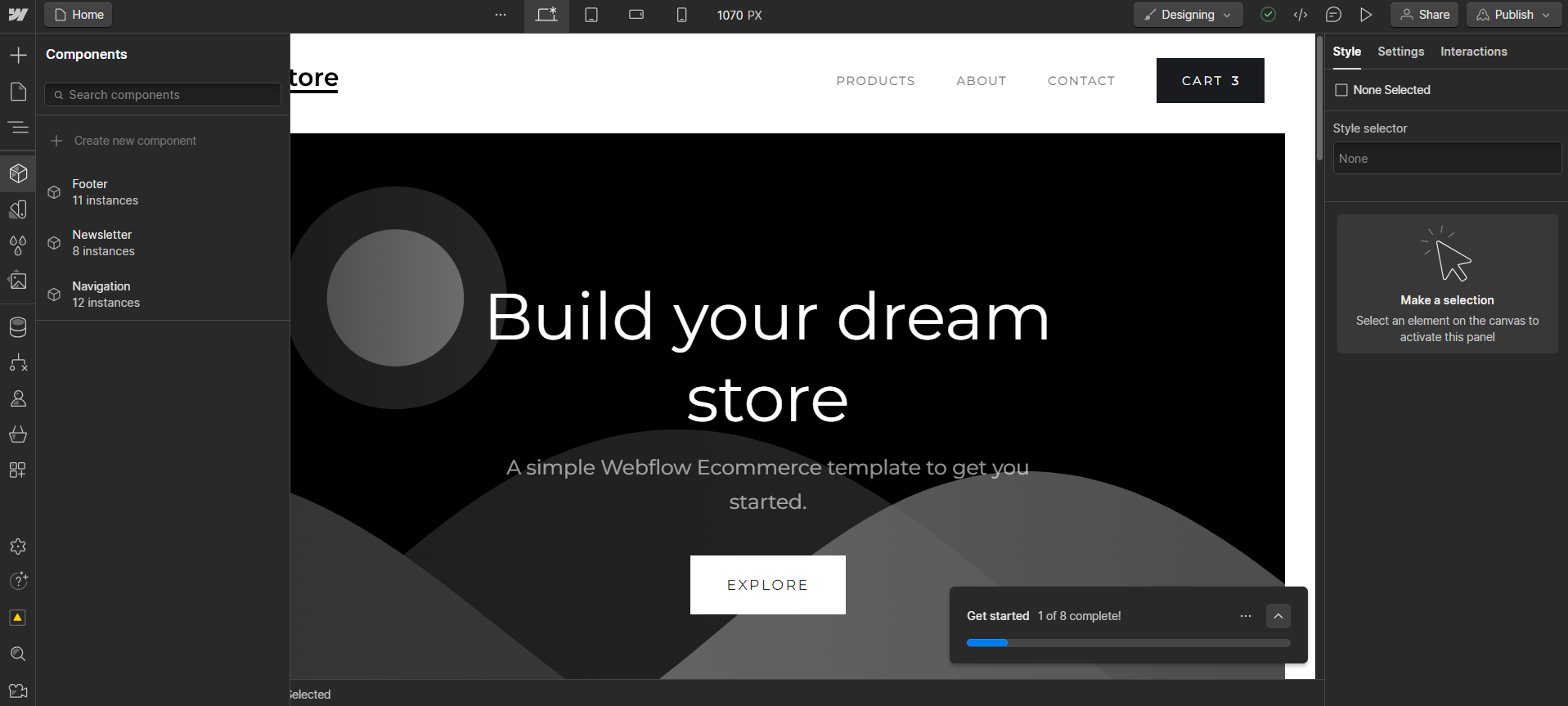
Portfoliobox, scoring 7.5, is a user-friendly website builder tailored for creative professionals, providing an array of tools for building and customizing portfolio websites. Features include blog management with a commenting system, customizable image galleries with security options, and the ability to sell digital products. It also supports SEO optimization, social media, and analytics integration for enhanced online presence. While praised for its ease of use and variety of features, some users may find it limited for advanced, detailed content needs.
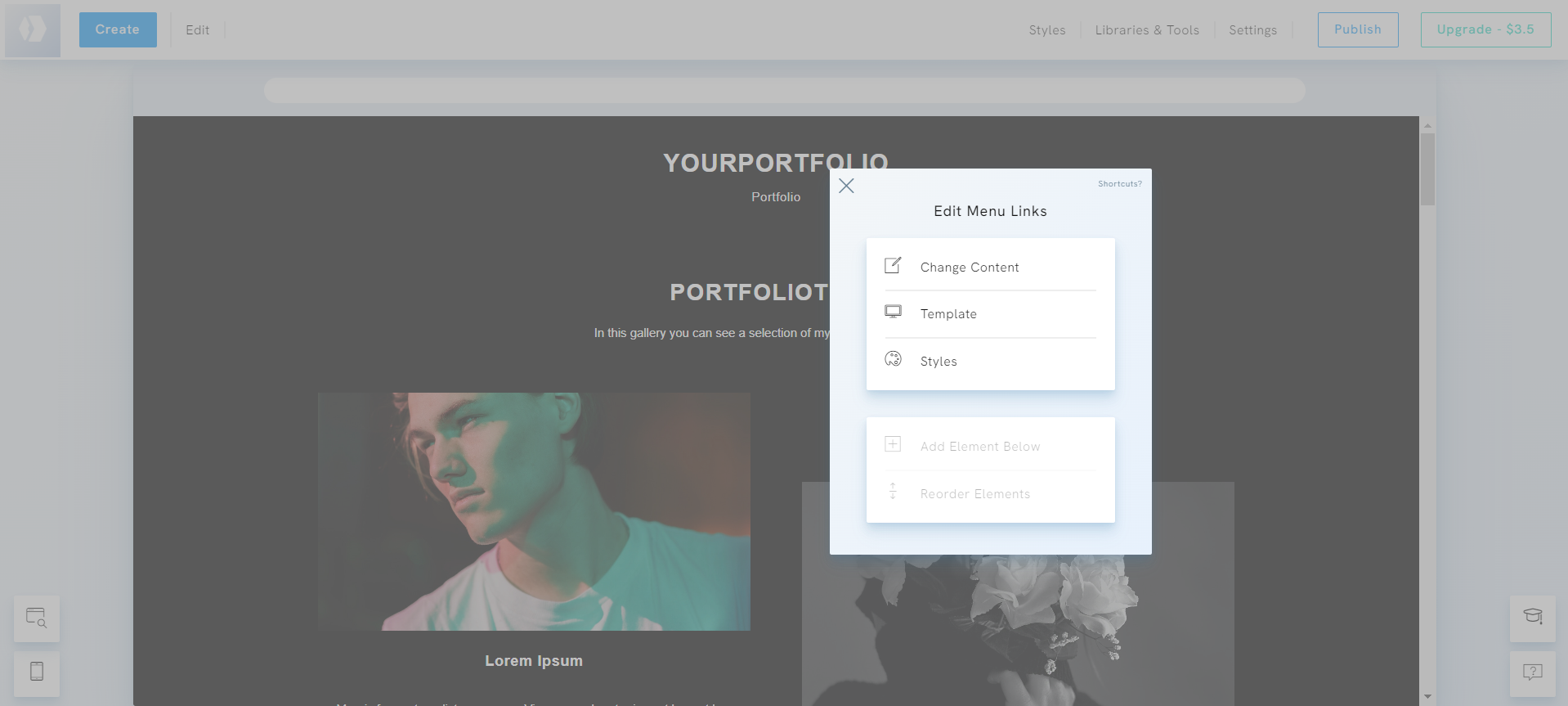
Mobile editor/app
 7.0
7.0
 0
0
🏆
Winner: Webflow
. Webflow offers a mobile editing solution through a third-party app called EditFlow, which is available for iOS users. This app allows Webflow users to make on-the-go adjustments to their websites, providing a level of flexibility and convenience for managing site content and design from a mobile device. While it is not an official app from Webflow, it still offers valuable functionality for users needing mobile access.
Portfoliobox, on the other hand, does not provide a dedicated mobile editor app, which limits its flexibility for users who need to make adjustments to their portfolio websites while away from their desktops.
In summary, Webflow takes the lead in this category due to the availability of a third-party mobile editing solution, whereas Portfoliobox lacks a mobile editor entirely.
Product testing options
Product Testing OptionsAssesses the options for trying out platform features before commitment.Score Components:
- Trial quality (40%): Extent and usefulness of the trial or free version.
- Feature accessibility (30%): How many features are available to test.
- Trial duration (20%): Length of the trial period.
- Ease of transition (10%): Smoothness of moving from trial to paid plans.
 6.3
6.3
 9.1
9.1
Overall Result
:
Portfoliobox wins
. Portfoliobox scores 9.1, significantly higher than Webflow’s 6.3, offering more comprehensive product testing options. Portfoliobox provides a 30-day free trial with access to all features and a 14-day money-back guarantee, allowing users to thoroughly test the platform. Webflow, while offering a free plan, limits the testing of premium features and does not provide a money-back guarantee.

|

|
|
|---|---|---|
|
Free Plan |
Yes | No |
|
Trial Duration |
No | 30 days |
|
Testing Premium Features |
Some basic features with free plan | All features within the trial period |
|
Money Back Guarantee |
No | 14-day money-back guarantee |
Price
PriceLooks at the cost-effectiveness and value for money of each platform.Score Components:
- Plan value (40%): What each pricing tier offers.
- Transparency and clarity (30%): Clearness of pricing structures.
- Flexibility of plans (20%): Range of options to suit different budgets.
- Hidden costs (10%): Additional expenses not included in the plan.
 8.0
8.0
 7.9
7.9
Webflow offers a wider range of pricing plans, including a free tier and custom enterprise solutions, while Portfoliobox provides more straightforward and affordable options without an enterprise plan.

|

|
|
|---|---|---|
|
Free |
Starter (Free): Limited features for new sites, including 2 static pages and 50 form submissions lifetime. |
No offering at this amount |
|
$0-$10 |
No offering at this amount |
Light ($5.50/month): 50 Images, 10 Pages, 5 Products, 1 Password Protected Page, 1 Booking Service, 1 Scheduling Service, 1 Invoice, 1 QR Code, 25 mb File Sharing Value for Price: 6.0 |
|
$10-$16 |
Basic ($18/month): Suitable for simple sites with a custom domain, including basic SEO controls and 500 monthly form submissions. And 100 pages. Value for Price: 6.5 |
Pro Plus ($18.50/month): 1,000 Images, 1,000 Pages, 1,000 Products, 1,000 Password Protected Pages, 1,000 Booking Services, 1,000 Scheduling Services, 1,000 Invoices, 1,000 QR Codes, 5,000 mb File Sharing, Customizable Templates, Free Custom Domain (yourname.com), 24/7 Support, No “Powered by Portfoliobox” Link, Adobe Lightroom Integration Value for Price: 9.0 |
|
$16-$35 |
CMS ($29/month): For content-driven sites with 2,000 CMS items, 1,000 monthly form submissions, and full API access. And 150 website pages. Value for Price: 7.5 |
Pro ($14.50/month): 500 Images, 50 Pages, 10 Products, 2 Password Protected Pages, 2 Booking Services, 2 Scheduling Services, 2 Invoices, 2 QR Codes, 50 mb File Sharing, Customizable Templates, Free Custom Domain (yourname.com), 24/7 Support Value for Price: 7.5 |
|
$40-$45 |
Standard ($42/month): For new businesses with up to 500 ecommerce items, includes basic ecommerce features, and 2% transaction fee Value for Price: 8.5 |
No offering at this amount |
|
$45-$50 |
Business ($49/month): High traffic capacity, advanced features like site search, and up to 10 content editors. Value for Price: 8.0 |
No offering at this amount |
|
$80-$90 |
Plus ($84/month): Higher volume businesses with 0% transaction fees, up to 5,000 ecommerce items, and advanced features. Value for Price: 9.0 |
No offering at this amount |
|
$200+ |
Advanced ($235/month): Scalable solution for large online stores with up to 15,000 ecommerce items and the highest caps and 0% transaction fees. Value for Price: 9.5 |
No offering at this amount |
location. As a result in rare cases the prices displayed here can differ from the ones you see on their
websites.
Hosting quality
Hosting
qualityExamines the reliability and performance of the hosting solutions.Score Components:
- Uptime (40%): Consistency and reliability of website availability.
- Speed (30%): Loading times and performance.
- Bandwidth and storage (20%): Sufficiency of resources provided.
- Data centers (10%): Quality and distribution of hosting infrastructure.
 8.9
8.9
 6.5
6.5
🏆
Winner: Webflow
Webflow’s managed hosting, CDN integration, and high uptime guarantee make it a robust choice for professional use. Portfoliobox, while user-friendly and suitable for creative professionals, lacks transparency in uptime and data center locations, impacting its hosting quality score. Webflow’s superior performance and reliability earn it a higher rating.

|

|
|
|---|---|---|
|
Do they offer hosting? |
Yes, included in all plans |
Yes, with unlimited bandwidth and secure communications through HTTPS on CDN servers |
|
Data Centers: |
Relies on a globally distributed network of data centers from Amazon Web Services (AWS) and Fastly |
Not disclosed |
|
Type of hosting: |
Managed Hosting |
Managed Cloud Hosting |
|
Uptime: |
99.99% |
Not disclosed |
|
Uptime Guarantee: |
Only Enterprise plan, 99.99% |
No |
Website Speed Optimization
Website Speed OptimizationEvaluates optimization of website loading timesScore Components:
- PageSpeed Score (30%): Google’s score indicating performance optimization.
- Loading Time (30%): The average time until a website is fully interactive.
- Mobile Optimization (15%): Optimization effectiveness for mobile devices.
- Resource Optimization (15%): Optimizing images, scripts, and other heavy resources.
- CDN Usage (10%): Use of CDN to enhance speed across geolocations.
 8.1
8.1
 6.4
6.4
🏆 Winner: Webflow
Both Webflow and Portfoliobox focus on website performance and page speed, but Webflow’s advanced optimization strategies and higher scores give it a clear advantage.

|

|
|
|---|---|---|
|
Focus |
Custom Cache Settings, Custom Element Lazy Loading, Automatic Minification, Responsive templates, CDN |
CDN, Caching, Responsive Design |
|
Performance Tools |
Google PageSpeed Insights, Lighthouse |
Google PageSpeed Insights |
|
Key Strategies |
Custom Cache Settings, Custom Element Lazy Loading, Automatic Minification, Responsive templates, CDN |
CDN, Caching, Responsive Design |
|
Load Times |
below 2 seconds average |
Varies depending on optimization |
|
Page Speed Scores Range |
77.2/100 |
Varies depending on optimization |
|
Core Web Vitals Improvement |
Improving components’ usability, and emphasis on LCP, FID and CLS |
No information provided |
Webflow excels in website speed optimization with a comprehensive set of strategies including custom cache settings, custom element lazy loading, automatic minification, and the use of responsive templates and CDN. These strategies ensure that Webflow sites load quickly and efficiently, with average load times below 2 seconds and a PageSpeed score of 77.2/100. Webflow also focuses on improving Core Web Vitals, particularly Largest Contentful Paint (LCP), First Input Delay (FID), and Cumulative Layout Shift (CLS), to enhance user experience.
Portfoliobox, while also employing CDN, caching, and responsive design for speed optimization, does not provide as detailed information on their strategies or performance metrics. The load times and PageSpeed scores for Portfoliobox sites vary depending on the level of optimization applied. Additionally, Portfoliobox does not offer specific information on improvements to Core Web Vitals, which may impact the overall user experience.
In conclusion, Webflow’s advanced optimization techniques and consistent performance metrics make it the superior choice for website speed optimization compared to Portfoliobox.
Get a head start on website creation with AI
Create a custom website tailored to your business needs 10X faster with 10Web AI Website Builder!
Plugins and integrations
Plugins and integrationsMeasures the range and effectiveness of additional plugins and integrations.Score Components:
- Variety of options (40%): Range of available add-ons.
- Integration smoothness (30%): Ease of integrating plugins into the site.
- Quality of plugins (20%): Functionality and reliability of the options.
- Custom integration capabilities (10%): Support for custom or third-party integrations.
 5.5
5.5
 7.2
7.2
🏆 Winner: Portfoliobox.
Portfoliobox scores 7.2, offering a wide range of plugins through platforms like Common Ninja and Elfsight, which enhance its functionality significantly. These plugins cover various needs, from social media feeds to e-commerce capabilities, making it a versatile choice for creative professionals. Webflow, with a score of 5.5, provides a built-in library of website elements and third-party integrations, but it lacks the extensive plugin support that Portfoliobox offers.
It is worth noting that while Webflow’s integrations are diverse and cater to different needs, Portfoliobox’s plugin support provides a more seamless and efficient website-building experience for users looking for advanced functionalities without extensive coding.
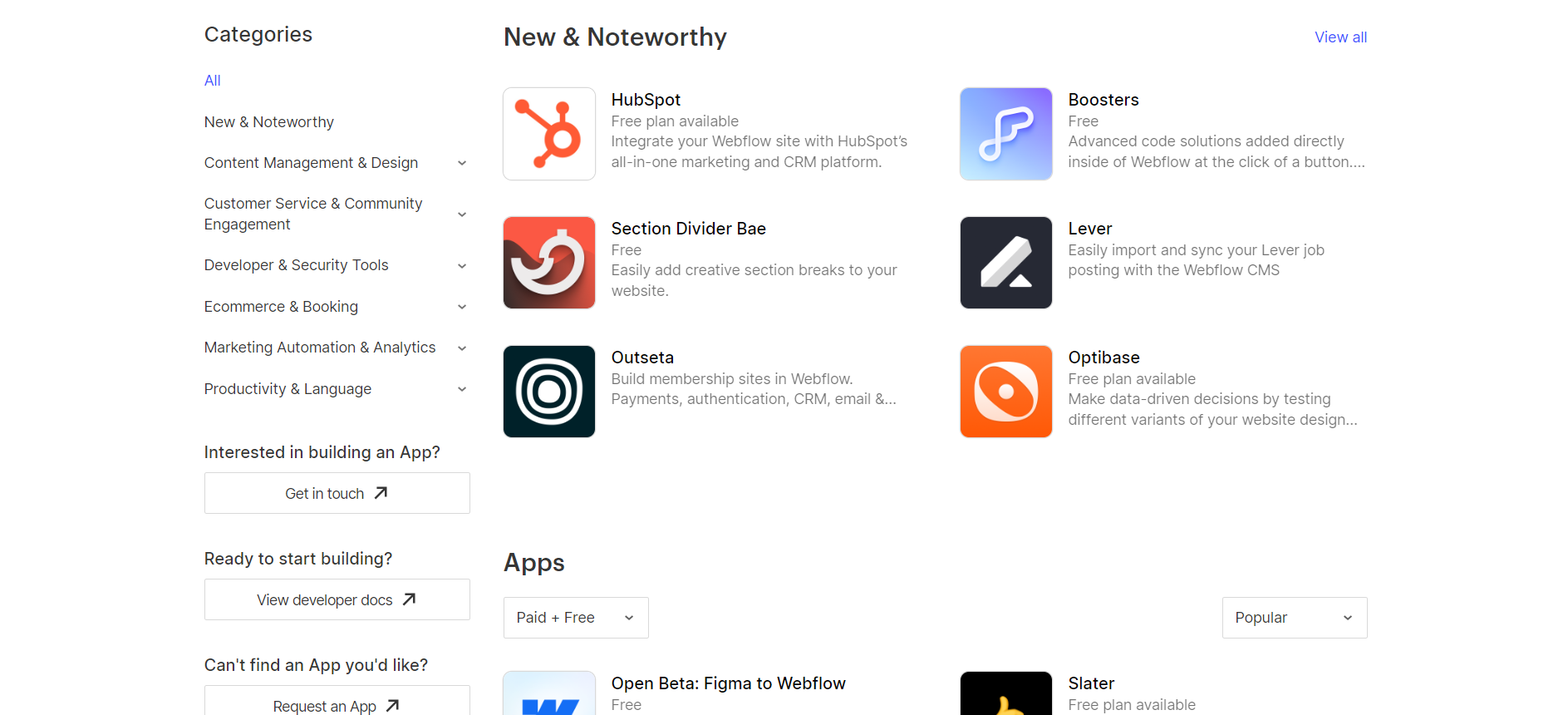
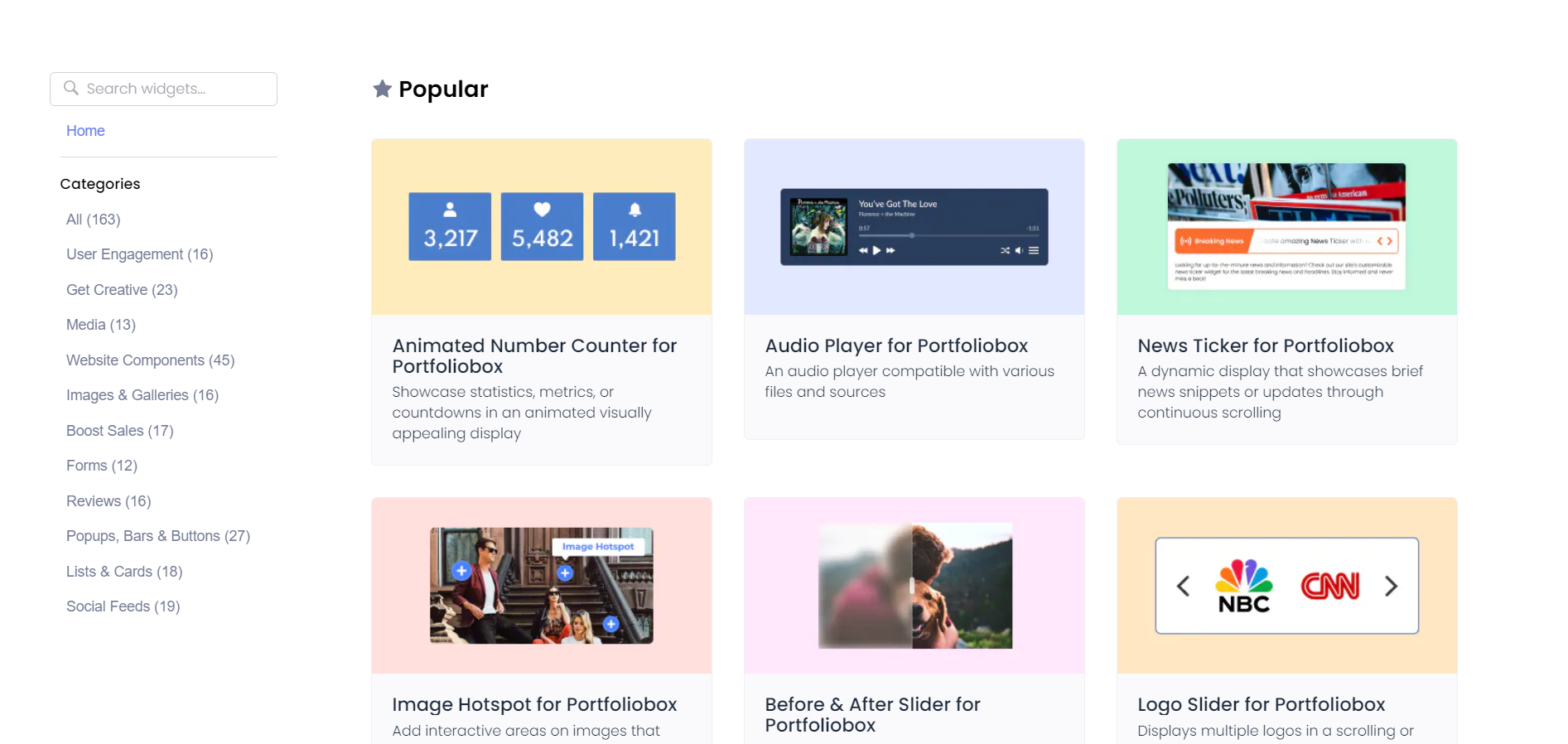
Marketing Features
Design FunctionalitiesRepresents how well each platform allows for creative design and customization of websites.Score Components:
- Template Variety (30%): Range and quality of design templates.
- Customization (30%): Flexibility and options for design alterations.
- User Interface (20%): Ease and intuitiveness of the design process.
- Responsiveness (10%): Adaptability to different devices and screen sizes.
- Innovation (10%): Unique design features and tools.
 7.8
7.8
 7.0
7.0
🏆
Overall Winner: Webflow
. Webflow excels with its comprehensive marketing tools, including advanced SEO, email marketing, and ad management features. Portfoliobox, while user-friendly and suitable for creatives, lacks some of the more advanced marketing functionalities.

|

|
|
|---|---|---|
|
SEO Tools |
✓ |
✓ |
|
Email Marketing |
✓ |
✓ |
|
Blogging |
✓ |
✓ |
|
Social Media Integration |
Simplifies content sharing and audience engagement on major social platforms |
Comprehensive integration for enhanced online presence |
|
Analytics and Reporting |
Integrates with Google Analytics for comprehensive web traffic and behavior analysis |
Comprehensive analytics with integration options |
|
Ads and Promotions |
Supports ad and promotion management through integration with platforms like Google Optimize |
No ads and promotions features |
Customer Support
Customer supportEvaluates the quality and availability of support options.Score Components:
- Response time (40%): Speed of support responses.
- Support quality (30%): Effectiveness and helpfulness of the support.
- Availability (20%): Range of support channels (phone, chat, email).
- Resource richness (10%): Quality of self-help and educational materials.
 8.3
8.3
 7.0
7.0
🏆 Winner: Webflow
. In the Webflow vs Portfoliobox comparison, Webflow takes the lead with a customer support score of 8.3. Webflow offers 24/7 support through live chat, email, and a community forum, ensuring users can get help whenever they need it. Additionally, Webflow provides extensive documentation and video tutorials, making it easier for users to navigate the platform and resolve issues independently.
Portfoliobox, with a customer support score of 7.0, also offers 24/7 support, but it lacks the extensive resources and specialized enterprise support that Webflow provides. While Portfoliobox’s dedicated team is always available to assist, the platform does not offer the same level of comprehensive support and resources as Webflow, making it less favorable for users who require more in-depth assistance.
Security
SecurityLooks at the platforms’ security measures and data protection.Score Components:
- Data protection (40%): Safeguards for user and customer data.
- SSL and encryption (30%): Implementation of secure connections.
- Compliance (20%): Adherence to industry security standards.
- Regular updates (10%): Frequency of security updates and patches.
 7.8
7.8
 8.1
8.1
🏆
Winner: Portfoliobox
. Portfoliobox excels in security with a comprehensive approach that includes GDPR compliance, clear data handling roles, and robust website security measures such as SSL certificates and two-factor authentication. These features ensure that user data is handled securely and transparently, making it a strong choice for creative professionals who prioritize data protection.
Webflow also offers solid security features, including SSL encryption, regular security audits, and two-factor authentication. However, its security score is slightly lower than Portfoliobox, indicating room for improvement in some areas. Despite this, Webflow remains a reliable option for those looking to build and manage secure websites.
AI Capabilities
AI capabilitiesMeasures the effectiveness of AI-driven features and tools.Score Components:
- Automation efficiency (40%): Impact of AI on streamlining processes.
- Personalization (30%): AI-driven customization for users or customers.
- AI-Assisted design (20%): Role of AI in website design and functionality.
- Data analysis (10%): Use of AI in interpreting user data and analytics.
 8.3
8.3
 0
0

|

|
|
|---|---|---|
|
AI Builder |
Planned AI features for design and content management |
No AI builder |
|
AI Ecommerce Features |
No ecommerce-specific AI features |
No AI ecommerce features |
|
AI Content Generation |
Planned AI content generation capabilities |
No AI content generation features |
|
Additional AI Features |
Announced plans for smart design suggestions and automated content updates |
No additional AI features |
🏆 Winner: Webflow
. Webflow, with a score of 8.3, has announced several AI features that are in development, including an AI copilot for design, AI-customized templates, and smart suggestions for design elements. These planned features aim to enhance the visual development process and content management, making it easier for users to create and maintain their websites.
Portfoliobox, with a score of 0, currently does not offer any AI capabilities. It focuses on providing a user-friendly platform for creative professionals to build and manage their portfolios without the need for technical skills.
User Management
User ManagementAssesses the platforms’ capabilities in managing user roles, permissions, and accessibility.Score Components:
- Role Customization (40%): Flexibility in creating and defining user roles and
permissions. - Ease of Management (30%): User interface and tools for managing users.
- Access Control (20%): Effectiveness of access control measures for different user
levels. - Scalability (10%): Ability to manage a growing number of users efficiently.
 8.3
8.3
 2.8
2.8
🏆 Winner: Webflow
. When it comes to managing users, Webflow offers a more robust and flexible system compared to Portfoliobox.
- Webflow allows multiple users to edit a website, with the number of users and their access levels varying by plan. Core, Growth, and Enterprise plans offer unlimited editors, while other plans limit content editors to 3 or 10 per site. Webflow also provides detailed role-based permissions and features like the Site Activity Log for enhanced collaboration and security.
- Portfoliobox, on the other hand, allows only one user to manage and edit a website, which can be a significant limitation for teams or collaborative projects.
Webflow User Roles and Access Levels:
| Role | Description | Access Highlights |
|---|---|---|
| Workspace Owner | Full control over Workspace settings and member management. | Edit settings, manage billing, access/edit all sites, invite/remove members, manage permissions. |
| Workspace Admin | Similar to the owner with some restrictions. | Edit settings, manage billing, access/edit all sites, invite/remove members (except owner), manage permissions. |
| Workspace Member | Limited control focused on site interaction. | Download invoices, access/edit sites, invite members. |
| Workspace Guest | Temporary collaborators with limited access. | Access/edit sites. |
| Workspace Commenter | Limited to commenting for feedback on sites. | Create/view/resolve comments, preview sites. |
| Site Admin | Full control at the site level. | Manage permissions, delete/transfer sites, billing management, design and publish changes. |
| Can Design | Design capabilities with some restrictions on publishing. | Design in Designer, create/modify classes and components, publish changes with permission. |
| Can Design (Limited) | Restricted design capabilities for Enterprise customers. | Create new classes, modify created classes, limited publishing capabilities. |
| Can Edit | Content editing without full design privileges. | Edit text/links/images, manage assets, publish Collection items and Ecommerce products. |
| Can Comment (Site Level) | Commenting for feedback at the site level. | Create/view/resolve comments, preview sites. |
Additional Features

|

|
|
|---|---|---|
|
SSL Certificate |
✓ |
✓ |
|
Custom Domain |
✓ |
✓ |
|
Free Custom Domain Included |
✓ |
✓ |
|
International Domains |
✓ |
✓ |
|
Mobile Responsive |
✓ |
✓ |
|
Page Speed |
✓ |
✓ |
|
Website Builder Mobile App |
X |
X |
|
Convert a Website To An App |
X |
X |
|
Website Analytics |
✓ |
✓ |
|
Multilingual Sites |
✓ |
✓ |
|
Multiple Users |
✓ |
X |
User Feedback
Webflow receives high praise for its user-friendly interface, eliminating the need for coding while offering extensive design flexibility. Users appreciate its scalability, cost-effectiveness, and seamless integration of essential features like forms and CMS. However, some users note a slight learning curve and occasional limitations, particularly in ecommerce functionalities and content management. Overall, Webflow proves to be a powerful tool for building and managing websites, offering robust features for both beginners and experienced developers, albeit with some room for improvement in certain areas like collaborative editing and content management.
Users overwhelmingly appreciate Portfoliobox for its user-friendly interface, making it straightforward for both beginners and professionals to create and manage online portfolios. The platform’s customizable design options, responsive layouts, and diverse template selection stand out as significant advantages, allowing users to express their personal style and showcase their work effectively across devices. However, some critiques include limited template options compared to competitors, a learning curve for less tech-savvy users, and minor glitches with features like autosave on different devices. Despite these challenges, the positive impact of Portfoliobox on users’ ability to present their work to potential clients and employers, along with its value in making portfolio creation accessible without coding knowledge, is consistently highlighted.
The making of this blog
We followed a clear, step-by-step process to write and research this article.
FAQ
Which platform is better for professional designers, Webflow or Portfoliobox?
Can I use both Webflow and Portfoliobox for ecommerce?
How do Webflow and Portfoliobox differ in terms of user-friendliness?
What are the major differences in pricing between Webflow and Portfoliobox?










